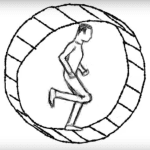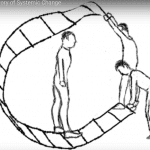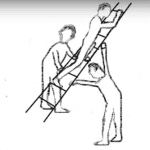Some time ago famvin posted an animated short story to illustrate systemic change. In it, treadmills were transformed into ladders.
Systemic change – an animated short story
The image and the text stay with me.
 “Systemic Change is about transforming structures (the wheel into the ladder), collaboration (the others rushing in to assist), and the involvement of the poor themselves in their own solution (the person climbs out of poverty himself, with the helpers holding the ladder in a supportive role).”
“Systemic Change is about transforming structures (the wheel into the ladder), collaboration (the others rushing in to assist), and the involvement of the poor themselves in their own solution (the person climbs out of poverty himself, with the helpers holding the ladder in a supportive role).”
Have you ever felt like a hamster on a treadmill? Running all the time but getting no place?
Think about that experience … and how it might help you understand systemic change. Think of the many programs we are responsible for or engaged in. Frequently today we give them the label “systemic change.” But are they?
Let’s take a soup kitchen or some similar program that meets great immediate needs. Going to a soup kitchen can be a bit like getting on a treadmill that doesn’t go anywhere. I need to stay on it to cope with my hunger because I don’t have a job. Looking deeper I need to stay on treadmill because I don’t have the skills needed in today’s market. So there I am stuck on a treadmill.
But what if we took seriously that time-honored perspective of Vincent and others… Give someone a sandwich and you feed that person for a day. But if you teach that person how to fish you feed them for lifetime. (1) Systemic change at its simplest. Like giving a hand up rather than a handout.
Systemic change is about more than immediate needs. (2) It is about addressing underlying causes and long-term solutions.
Back to the text of the animated story. To get off the treadmill it often requires steadying hands of others. Ultimately I am the the one who steps off the treadmill. But I need the collaboration of people who hold my hand, people who construct ladders and help me climb them.

So maybe the next time you think about a program you are involved in ask does this program help people survive or does it provide people a hand up and a ladder out of poverty. We do need to bandage wounds. But we also need to think about ladders – making sure there are ladders and helping people unsteady on their feet to climb those ladders.
When this animated story was first published Ray Pawlicki made this comment…
Ray Pawlicki May 1, 2013 at 8:43 pm
Irudayam, good point. My conference is teaching families to keep honey bees and giving them 5 hives to get started along with the protective equipment. Honey prices are at all time highs. Although not a universal solution perhaps other conferences can think of better employment opportunities.
Endnotes:
1. Of course I take that one step further. That person has to have access to a lake with fish! What good does it do to know how to harvest fruit if no one hires you to go out into the vineyard?
2. We will always need programs that address immediate needs and bind up wounds.








0 Comments